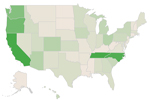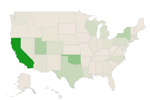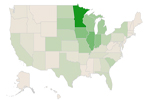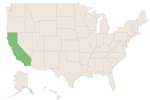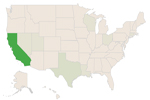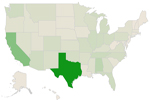Maps and Data - Fuel Use by Transportation Mode in 2019
Find maps and charts showing transportation data and trends related to alternative fuels and vehicles.
OR
Sort by:
119 results
-
Fuels & Infrastructure: Fuel Trends
-
-
Average Annual Retail Fuel Price of Gasoline
Trend of gasoline prices, actual and inflation-adjusted, from 1950 to 2023 Last update January 2024
-
-
-
Average Renewable Diesel and Diesel Fuel Prices in California
Trend of renewable diesel and diesel motor fuel prices in California from 2017 to 2024 Last update October 2024
-
-
-
Average Retail Fuel Prices in the United States
Trend of alternative and traditional motor fuel prices from 2000 to 2024 Last update October 2024
-
-
-
Change in U.S. Light-Duty Vehicle Registration Counts
Trend of light-duty vehicle registrations by fuel type, measured in percent change from 2016 through 2023 Last update June 2024
-
-
-
Consumption of Natural Gas in the United States
U.S. natural gas consumption by end use in 2022 Last update January 2024
-
-
-
Energy Use by Transportation Mode and Fuel Type
Amount of energy consumed through different transportation modes, 2019 Last update May 2023
-
-
-
Fuel Taxes by Country
Comparison of gasoline and diesel taxes in Organization for Economic Cooperation and Development countries Last update March 2019
-
-
-
Fuel Use by Transportation Mode in 2019
Breakdown of fuel used in the United States by transportation mode, 2019 Last update May 2023
-
-
-
Global Ethanol Production by Country or Region
Quantity of ethanol produced by country/region from 2007 to 2022 Last update January 2024
-
-
-
Renewable Diesel Production and Consumption
Renewable diesel domestic production and consumption from 2013 to 2023 Last update October 2024
-
-
-
Sustainable Aviation Fuel Estimated Consumption
Estimated U.S. consumption of sustainable aviation fuel from 2016 to 2023 Last update September 2023
-
-
-
U.S. Biodiesel Production, Exports, and Consumption
Trend of biodiesel production, exports, and consumption from 2001 to 2023 Last update April 2024
-
-
-
U.S. Crude Oil Imports by Country of Origin
Quantity of oil imports by country of production, from 1973 to 2023 Last update December 2023
-
-
-
U.S. Production, Consumption, and Trade of Ethanol
Trend of total ethanol fuel production and consumption from 2000 to 2023 Last update October 2024
-
-
-
U.S. Production, Consumption, and Trade of Petroleum Products
Trend of total petroleum product production, consumption, and trade from 1949 to 2023 Last update November 2023
-
-
-
U.S. Renewable Diesel Imports
Renewable diesel fuel imports to the United States from 2015 to 2023 Last update October 2024
-
-
Fuels & Infrastructure: Emissions
-
-
Greenhouse Gas Emissions by Economic Sector
Trend of U.S. greenhouse gas emission for each economic sector Last update May 2024
-
-
Fuels & Infrastructure: Alternative Fueling Stations
-
-
Biodiesel Fueling Station Locations by State
Displays states and their respective biodiesel station counts
-
-
-
Compressed Natural Gas Fueling Stations by State
Displays states and their respective compressed natural gas (CNG) station counts
-
-
-
E85 Fueling Station Locations by State
Displays states and their respective E85 station counts
-
-
-
Electric Vehicle Charging Ports by State
Displays states and their respective EV charging port counts
-
-
-
Hydrogen Fueling Station Locations by State
Displays states and their respective hydrogen station counts
-
-
-
Liquefied Natural Gas Fueling Stations by State
Displays states and their respective liquefied natural gas (LNG) station counts
-
-
-
Propane Fueling Station Locations by State
Displays states and their respective propane station counts
-
-
-
Renewable Diesel Fueling Station Locations by State
Displays states and their respective renewable diesel station counts
-
Fuel Use by Transportation Mode in 2019
Source: Oak Ridge National Laboratory, Transportation Energy Data Book #40, Table 2.8
This chart shows the fuel used for domestic transportation in the United States. The largest amount is used in the form of gasoline by light-duty vehicles. The second largest portion is used in the form of diesel fuel in medium- and heavy-duty vehicles. Air travel consumes 7% of transportation petroleum, primarily in the form of jet fuel. Water and rail travel together consume 5% in the form of diesel fuel and some gasoline and electricity. Finally, pipelines consume 3% of transportation fuel, mostly in the form of natural gas.
To view more details, notes, and acronyms, please download the Excel spreadsheet.
Print



















